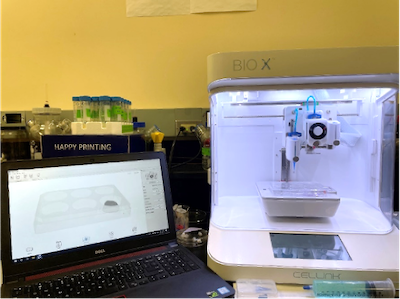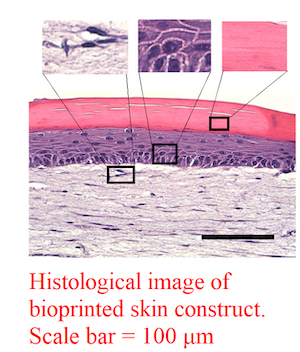Authors: Gurtej Singh PhD, Alexander Dagum MD, Marcia Simon, PhD, and Miriam Rafailovich, PhD
Skin tissue engineering is a surgical procedure that involves removing the skin from one area of your body and moving it to different area of our body. This method involving 3-D printing has allowed surgeons to place skin grafts over an area of the body where the skin has been lost. It is commonly used for treating skin cancer surgery, mending a large open wound, treating sores on the skin that have healed poorly, and treating burns. This procedure is used as a more modern, cutting edge approach to heal skin injuries and burns. A research study was conducted by our doctors to present how the new level of skin tissue engineering has vastly surpassed the conventional method of repairing skin.

analogues. With its superiorities (low cost, high efficiency, and capability of large scalable production), bioprinting has become the game changer in tissue engineering and regenerative medicine |
 |
Below are some questions relevant to the study, comparing 3-D bioprinting and traditional methods.
Q: What does the study show in terms of advantages 3-D print generated skin has over traditional methods?
A: Our study shows that 3D printing can produce excellent skin equivalents at par or possibly better than the traditional methods. Moreover, 3D printing has the advantage that the skin equivalents can be printed using multiple cell types, such as cells that have been genetically modified for enhanced performance or to correct genetic abnormalities. Angiogenesis, or the incorporation of functional blood vessels is the holy grail of tissue engineered organs, yet there has been little success in this area. 3D printing can overcome this issue through the printing of skin models with self-assembled arterial or venous network. Finally, it opens the possibility of printing tailored skin patches for first responders in remote locations, which can be packaged and applied onto a wound, like a living bandage. Hence, it is a transformative technology with the ability to be automated and standardized.
Q: What are the potential clinical applications?
A: These skin constructs provide the "living bandage" which can be shipped to first responders in the field, such as soldiers or firefighters in remote locations, who are susceptible to serious injury or burns over large areas of their body. The printed skin allows for automation, rapid deployment, and autologous construction. When not required for clinical remedies, the technique is easily adaptable in laboratories, and the skin, which is technically alive and functional, can be used to test drug therapies with toxicity potential before they are introduced to human such as transdermal vaccines. Consumer skin products such as cosmetics, cleaning products, etc. can be tested on these skin models to provide accurate results regarding human tissue response, without using either real humans or animals.
Q: This appears to be work with results in lab only. What about any constructs with animals or in human patients?
A: The skin constructs can be used for lab-based testing, as we said previously. BUT, if they are printed in a GMP facility, then they can be used on humans in clinical settings. GMP manufacturing is very costly, but the technology is life saving and worth the cost when needed. In fact Dr. Marcia Simon, a co-author of this paper, has been constructing a facility to transition her Living Skin Bank from laboratory to clinical practice.
Q: Next steps of research?
A: We are currently working on incorporating blood vessels into these skin constructs to create a "true" skin replacement with faster healing properties.

